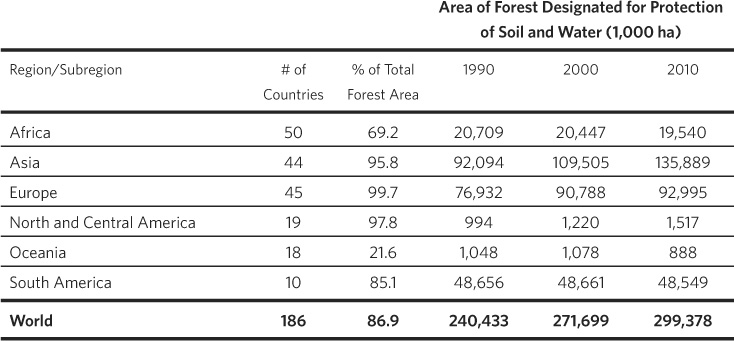SCIENCE LITERACY WORKING WITH DATA
The data in the following table come from the 2010 assessment of global forest resources conducted by the Food and Agriculture Organization of the United Nations. This table reports on the global and regional trends in forest areas designated primarily for the protection of soil and water.

Interpretation
1. How much total forest area was designated for protection of soil and water globally in 2000? In 2010? (Hint: Don’t forget to account for the units of measure shown in the header.)
2000: 271,699,000 ha
2010: 299,378,000 ha
2. Summarize the trends in forest lands set aside for the protection of soil and water:
Between 1990 and 2010, how much has the total (global) area grown or decreased?
Between 1990 and 2010, which major region showed the most gain, and how much did it gain?
Between 1990 and 2010, which major region showed the most loss, and how much did it lose?
a. Global changes between 1990 to 2010: A gain of 58,945,000 ha (299,378,000 — 240,433,000)
b. The most gain between 1990 to 2010 was seen in Asia — a gain of 43,795,000 ha (135,889,000 — 92,094,000 )
c. The most loss between 1990 to 2010 was seen in Africa — loss of 1,169,000 ha (20,709,000 — 19,540,000)
Advance Your Thinking
Hint: To answer some of the following questions, it might help to access the actual report, at www.fao.org/forestry/fra/fra2010/en. (See Chapter 6 of the report—Protective Functions of Forest Resources.)
3. What might explain the patterns seen in the table?
The global increase in forests designated for protection of soil and water of about 59 million hectares between 1990 and 2010 likely reflects increasing awareness of the ecosystem services provided by forests. The largest gain in such forest designation is in Asia; this due to large-scale forest planting in China to control desertification and conserve soil and water resources.
4. Why does the United States not report any forest area designated for protection of soil and water? How might this affect how the data presented in the table are interpreted?
The lack of specific forest designation for protection of soil and water in the United States is due to the fact that in the U.S. such ecological services are considered integral in the development of all forest policy and management practices. As explained in the chapter, the main forest legislation in the U.S. is the 1960 Multiple-Use Sustained Yield Act, which mandates that national forests be managed in a way that balances a variety of uses (outdoor recreation and timber interests as well as the health of watersheds, fish and wildlife) with no single use predominating. More recently forest ecologists are promoting the Forest Ecosystem Management approach, which focuses on managing the forest ecosystem as a whole.
This suggests that caution should be used in interpreting data such as presented in this table, as the term ‘protection’ of specific ecosystem services may mean different things for different regions based on local policies and regulations.
5. If the world population is 7 billion, what is the per capita amount of forest land that is set aside for soil and water protection?
Total forest area designated for protection soil and water = 299,378,000 hectares
Total world population = 7,000,000,000
Per capita forest land set aside for soil and water protection = 299,378,000 / 7,000,000,000 = 0.042 ha per person